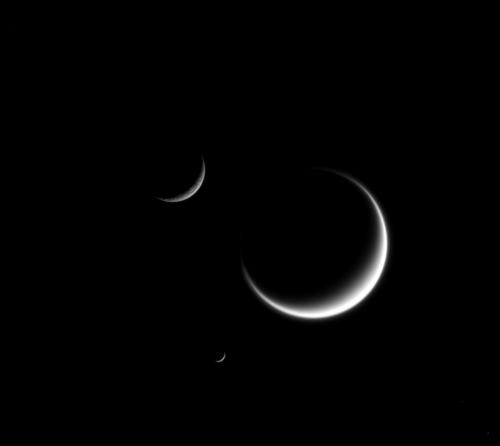Europa has always held a fascination to me. I think it’s the concept of a world with a sub-surface ocean and the possibility of life that has inspired me and many others. In September 2022, NASAs Juno spacecraft made a flyby, coming within 355 kilometres of the surface. Since the encounter, scientists have been exploring the images and have identified regions where brine may have bubbled to the surface. Other images revealed possible, previously unidentified steep-walled depressions up to 50km wide, this could be caused by a free-floating ocean!
Continue reading “Juno Reveals Secrets About Europa’s Icy Surface”Twelve New Moons Discovered Around Jupiter, and One of Them is Pretty Odd!
The gas giant Jupiter, which was named in honor of the king of the gods in the Roman pantheon, has always lived up to its name. In addition to being the largest planet in the Solar System – with two and a half times the mass of all the other planets combined – it also has an incredibly powerful magnetic field and the most intense storms of any planet in the Solar System.
What’s more, it is home to some of the largest moons in the Solar System (known as the Galilean Moons), and has more known moons than any other planet. And thanks to a recent survey led by Scott S. Sheppard of the Carnegie Institution of Science, twelve more moons have been discovered. This brings the total number of known moons around Jupiter to 79, and could provide new insight into the history of the Solar System.
The team was led by Scott S. Sheppard and included Dave Tholen (University of Hawaii) and Chad Trujillo (Northern Arizona University). It was this same team that first suggested the existence of a massive planet in the outer reaches of the Solar System (Planet 9 or Planet X) in 2014, based on the unusual behavior of certain populations of extreme Trans-Neptunian Objects (eTNOs).

Curiously enough, it was while Sheppard and his colleagues were hunting for this elusive planet that they spotted the first of these new moons in 2017. As Sheppard explained in a recent Carnegie press release:
“Jupiter just happened to be in the sky near the search fields where we were looking for extremely distant Solar System objects, so we were serendipitously able to look for new moons around Jupiter while at the same time looking for planets at the fringes of our Solar System.”
The initial discoveries were made using the Blanco 4-meter telescope at the Cerro Tololo Inter-American Observatory (CTIO) in Chile. They were then confirmed with the help of the Dark Energy Camera (DECam), which was added to the Blanco telescope as past of the Dark Energy Survey. Additional data was provided by the Carnegie Observatories 6.5-meter Magellan Telescopes.
The orbits of the newly-discovered moons were then calculated by Gareth Williams of the International Astronomical Union’s Minor Planet Center (MPC), based on the team’s observations. “It takes several observations to confirm an object actually orbits around Jupiter,” he said. “So, the whole process took a year.”
As you can see from the image above, two of the newly-discovered moons (indicated in blue) are part of the inner group that have prograde orbits (i.e. they orbit in the same direction as the planet’s rotation). They complete a single orbit in a little less than a year, and have similar orbital distances and angles of inclination. This is a possible indication that these moons are fragments of a larger moon that was broken apart, possibly due to a collision.
Nine of the new moons (indicated in red) are part of the distant outer group that have retrograde orbits, meaning they orbit in the opposite direction of Jupiter’s rotation. These moons take about two years to complete a single orbit of Jupiter and are grouped into three orbital groups that have similar distances and inclination. As such, they are also thought to be remnants of three larger moons that broke apart due to past collisions.
The team observed one other moon that does not fit into either group, and is unlike any known moon orbiting Jupiter. This “oddball moon” is more distant and more inclined than the prograde moons and takes about one and a half years to orbit Jupiter, which means its orbit crosses the outer retrograde moons. Because of this, head-on collisions are much more likely to occur with the retrograde moons, which are orbiting in the opposite direction.
The orbit of this oddball moon was also confirmed by Bob Jacobson and Marina Brozovic at NASA’s Jet Propulsion Laboratory in 2017. This was motivated in part to ensure that the moon would not be lost before it arrived at the predicted location in its orbit during the recovery observations made in 2018. As Sheppard explained,
“Our other discovery is a real oddball and has an orbit like no other known Jovian moon. It’s also likely Jupiter’s smallest known moon, being less than one kilometer in diameter…This is an unstable situation. Head-on collisions would quickly break apart and grind the objects down to dust.”

Here too, the team thinks that this moon could be the remains of a once-larger moon; in this case, one that had a prograde orbit that formed some of the retrograde moons through past collisions. The oddball moon already has a suggested name for it – Valetudo, after the Jupiter’s great-granddaughter, the goddess of health and hygiene in the Roman pantheon.
In addition to adding to Jupiter’s overall moon count, the study of what shaped these moon’s orbital histories could teach scientists a great deal about the earliest period of the Solar System. For instance, the fact that the smallest moons in Jupiter’s various orbital groups (prograde, retrograde) are still abundant suggests that the collisions that created them occurred after the era of planet formation.
According to the Nebular Hypothesis of Solar System formation, the Sun was still surrounded by a rotating protoplanetary disk at this time – i.e. the gas and dust from which the planets formed. Because of their sizes – 1 to 3 km – these moons would have been more influenced by surrounding gas and dust, which would have placed a drag on their orbits and caused them to fall inwards towards Jupiter.
The fact that these moons still exist shows that they likely formed after this gas and dust dissipated. In this respect, these moons are much like time capsules or geological records, preserving pieces of Jupiter’s (and the Solar Systems) history of formation and evolution.
This research was partially funded by a NASA Planetary Astronomy grant, and was made possible thanks to assistance by multiple observatories. These included the 4-meter Discovery Channel Telescope at Lowell Observatory Arizona, the 8-meter Subaru Telescope and the University of Hawaii’s 2.2 meter telescope, and the 8-meter Gemini Telescope in Hawaii.
Further Reading: Carnegie Institute of Science
By Jove: Jupiter at Opposition for 2018
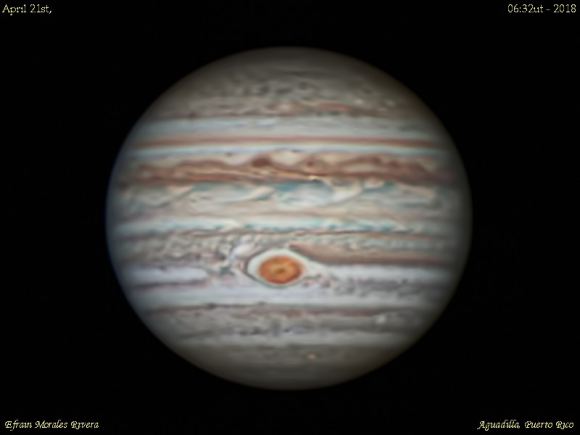
It’s a question I’ve fielded lots this weekend leading up to last night’s April Pink Full Moon, and one I expect we’ll get again tonight: “What’s that bright star near the Moon?”
That bright “star” is actually a planet, the king of them all as far as our Solar System is concerned: Jupiter. May also ushers in Jupiter observing season, as the planet reaches opposition on May 9th, rising in the east opposite to the setting Sun to the west. Jupiter now joins Venus in the dusk sky, ending the planetary drought plaguing many an evening star party.
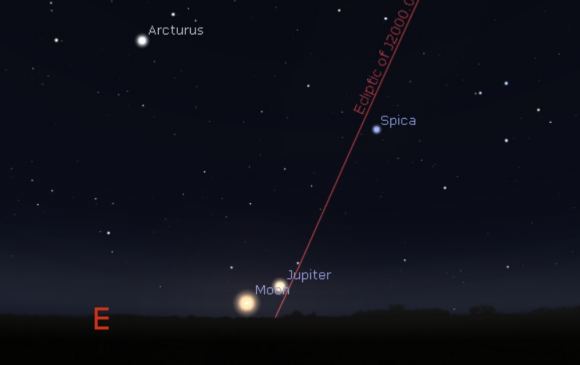
All planetary news seems to lead back to Jupiter this season. Just last week, we wrote about a recent study, suggesting that Jupiter actually gets hit by asteroids and comets on a much more regular basis than astronomers thought.
It’s always worth keeping a sharp eye on Jupiter. Shining a magnitude -2.5 near opposition, you can even pick Jupiter out against the deep blue daytime sky… if you know exactly where to look for it. The Moon visits Jupiter once every orbit, and the next time to try this feat of visual athletics is on May 27th, just before sunset.
Jupiter is 4.4 astronomical units (658 million kilometers) distant at opposition this year, and presents a disk 45” across.
At the eyepiece, Jupiter presents a roiling upper atmosphere, completing an amazing rotation once every 9.9 hours. This is not only fast enough to give Jove a noticeable equatorial bulge at its equator, but you can also observe and image Jupiter in its entirety in just one clear evening.
One of the first things that becomes apparent observing Jupiter at low power are its retinue of four Galilean moons. These are, from interior outward: Io, Europa, Ganymede and Callisto. Speedy Io takes just 1.8 days to orbit Jupiter once, while outermost Callisto takes a leisurely 16.7 days to make one circuit around Jupiter. Not only is it fun to note the changes in configuration of Jupiter’s major moons from night to night, but it’s interesting to watch them cast shadows onto Jupiter’s cloud tops and alternately disappear and reappear in and out of Jupiter’s shadow.
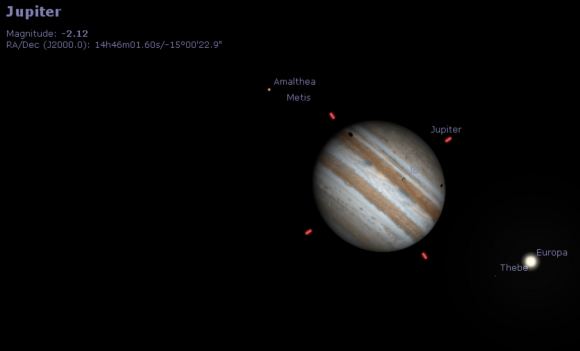
A few times a year, you can catch two moons casting a shadow on Jupiter at once. These usually happen in seasons, with the next pair involving Io and Europa (the most frequent transiters) set to occur on July 30th, 2018. Rarer still are triple transits, which last occurred on January 24th, 2015 and will happen next on March 20th, 2032. You’ll never see a quadruple transit though… and the outermost moon Callisto is the only one that can “miss” Jupiter, as it does in 2018.
The celestial scene changes, too, like a spotlight cast over the stage of the sky. At opposition, for example, Jupiter and its moons cast their respective shadows straight back, nearly behind them from our perspective. Watch how this changes, however, as Jupiter heads towards quadrature at 90 degrees elongation east of the Sun on August 6th, 2018 and we see Jupiter and its moons cast their shadows to the side.
Danish astronomer Ole Rømer noted a discrepancy in the timings of shadow transits near opposition versus quadrature and correctly realized that light from the events was actually taking time to transit from Jupiter to his telescope on Earth, and made the first crude measurement of the speed of light in 1676.
Crank up the magnification, and the Great Red Spot will pop into view if it’s turned Earthward. Though this centuries-long storm has been shrinking in recent years, it also seems to be condensing and reddening once again, versus the pale salmon color its exhibited as of late. How old is the Great Red Spot? Will it disappear this century, disappointing legions of school kids who diligently crayon in a ruby red eye on Jove?
One thing is for sure; the face of Jove does change over time. Another interesting example is the disappearing act that Jove’s Southern Equatorial Belt (SEB) makes every decade or so… this last occurred during 2010 season, and we may soon be due again. It would be an amazing scientific opportunity if this were to occur before NASA’s Juno spacecraft completes its mission this summer. Our question: why does the SEB disappear, while the NEB seems to be a permanent fixture on Jove?
All mysteries presented by the largest planet in our solar system, this opposition season 2018.
-Track the positions of Jupiter’s moons and the Great Red Spot using the SETI PDS Rings node, S&T’s app and Project Pluto.
Moonspotting-A Guide to Observing the Moons of the Solar System
Like splitting double stars, hunting for the faint lesser known moons of the solar system offers a supreme challenge for the visual observer.
Sure, you’ve seen the Jovian moons do their dance, and Titan is old friend for many a star party patron as they check out the rings of Saturn… but have you ever spotted Triton or Amalthea?
Welcome to the challenging world of moon-spotting. Discovering these moons for yourself can be an unforgettable thrill.
One of the key challenges in spotting many of the fainter moons is the fact that they lie so close inside the glare of their respective host planet. For example, +11th magnitude Phobos wouldn’t be all that tough on its own, were it not for the fact that it always lies close to dazzling Mars. 10 magnitudes equals a 10,000-fold change in brightness, and the fact that most of these moons are swapped out is what makes them so tough to see. This is also why many of them weren’t discovered until later on.
But don’t despair. One thing you can use that’s relatively easy to construct is an occulting bar eyepiece. This will allow you to hide the dazzle of the planet behind the bar while scanning the suspect area to the side for the faint moon. Large aperture, steady skies, and well collimated optics are a must as well, and don’t be afraid to crank up the magnification in your quest. We mentioned using such a technique previously as a method to tease out the white dwarf star Sirius b in the years to come.
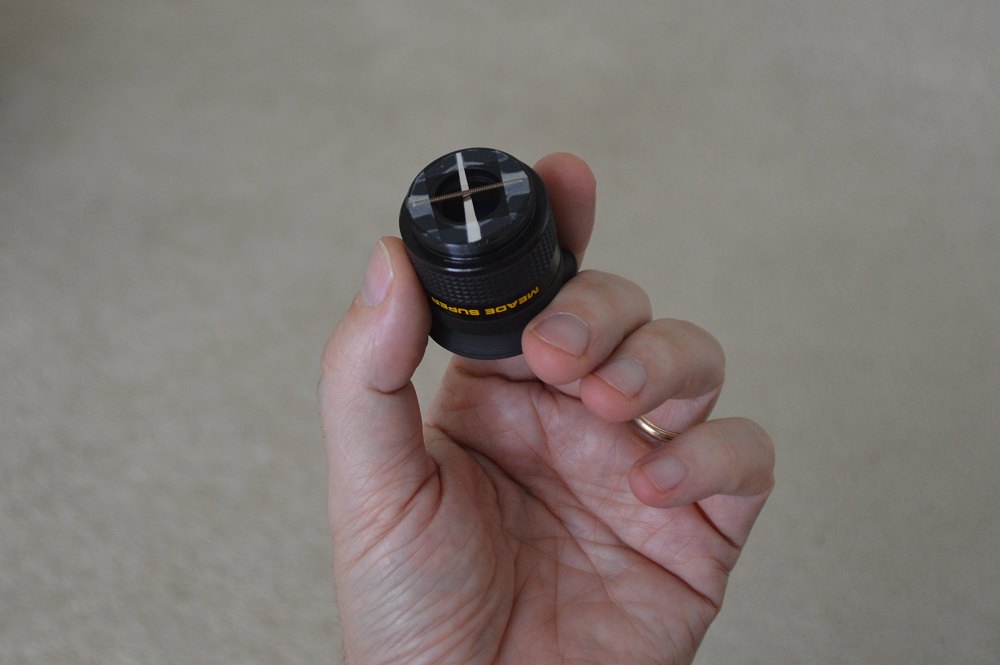
What follows is a comprehensive list of the well known ‘easy ones,’ along with some challenges.
We included a handy drill down of magnitudes, orbital periods and maximum separations for the moons of each planet right around opposition. For the more difficult moons, we also noted the circumstances of their discovery, just to give the reader some idea what it takes to see these fleeting worlds. Remember though, many of those old scopes used speculum metal mirrors which were vastly inferior to commercial optics available today. You may have a large Dobsonian scope available that rivals these scopes of yore!
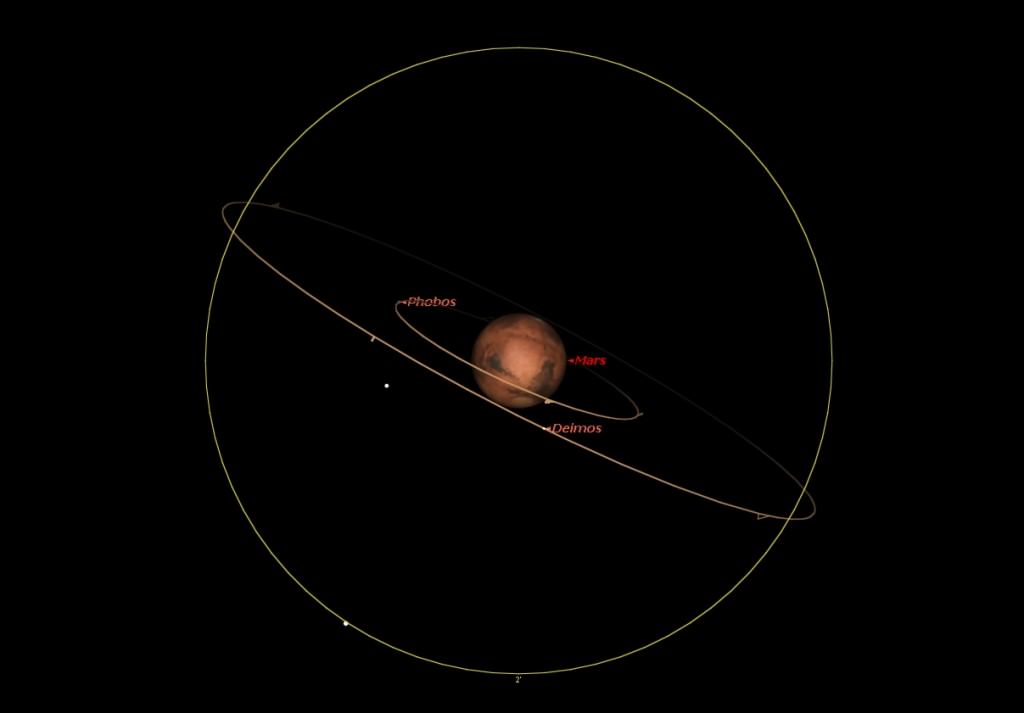
Mars- The two tiny moons of Mars are a challenge, as it’s only possible to nab them visually near opposition, which occurs about once every 26 months. Mars next reaches opposition on May 22nd, 2016.
Phobos:
Magnitude: +11.3
Orbital period: 7 hours 39 minutes
Maximum separation: 16”
Deimos:
Magnitude: +12.3
Orbital period: 1 day 6 hours and 20 minutes
Maximum separation: 54”
The moons of Mars were discovered by American astronomer Asaph Hall during the favorable 1877 opposition of Mars using the 26-inch refracting telescope at the U.S. Naval Observatory.
Jupiter- Though the largest planet in our solar system also has the largest number of moons at 67, only the four bright Galilean moons are easily observable, although owners of large light buckets might just be able to tease out another two. Jupiter next reaches opposition March 8th, 2016.
Ganymede:
Magnitude: +4.6
Orbital period: 7.2 days
Maximum separation: 5’
Callisto
Magnitude: +5.7
Orbital period: 16.7 days
Maximum separation: 9’
Io
Magnitude: +5.0
Orbital period: 1.8 days
Maximum separation: 1’ 50”
Europa
Magnitude: +5.3
Orbital period: 3.6 days
Maximum separation: 3’
Amalthea
Magnitude: +14.3
Orbital period: 11 hours 57 minutes
Maximum separation: 33”
Himalia
Magnitude: +15
Orbital period: 250.2 days
Maximum separation: 52’
Note that Amalthea was the first of Jupiter’s moons discovered after the four Galilean moons. Amalthea was first spotted in 1892 by E. E. Barnard using the 36” refractor at the Lick Observatory. Himalia was also discovered at Lick by Charles Dillon Perrine in 1904.
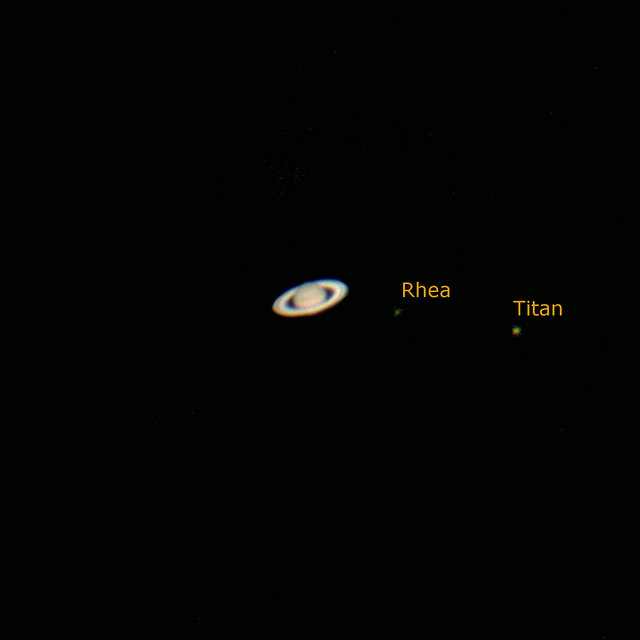
Saturn- With a total number of moons at 62, six moons of Saturn are easily observable with a backyard telescope, though keen-eyed observers might just be able to tease out another two:
(Note: the listed separation from the moons of Saturn is from the limb of the disk, not the rings).
Titan
Magnitude: +8.5
Orbital period: 16 days
Maximum separation: 3’
Rhea
Magnitude: +10.0
Orbital period: 4.5 days
Maximum separation: 1’ 12”
Iapetus
Magnitude: (variable) +10.2 to +11.9
Orbital period: 79 days
Maximum separation: 9’
Enceladus
Magnitude: +12
Orbital period: 1.4 days
Maximum separation: 27″
Dione
Magnitude: +10.4
Orbital period: 2.7 days
Maximum separation: 46”
Tethys
Magnitude: +10.2
Orbital period: 1.9 days
Maximum separation: 35”
Mimas
Magnitude: +12.9
Orbital period: 0.9 days
Maximum separation: 18”
Hyperion
Magnitude: +14.1
Orbital period: 21.3 days
Maximum separation: 3’ 30”
Phoebe
Magnitude: +16.6
Orbital period: 541 days
Maximum separation: 27’
Hyperion was discovered by William Bond using the Harvard observatory’s 15” refractor in 1848, and Phoebe was the first moon discovered photographically by William Pickering in 1899.

Uranus- All of the moons of the ice giants are tough. Though Uranus has a total of 27 moons, only five of them might be spied using a backyard scope. Uranus next reaches opposition on October 12th, 2015.
Titania
Magnitude: +13.9
Orbital period:
Maximum separation: 28”
Oberon
Magnitude: +14.1
Orbital period: 8.7 days
Maximum separation: 40”
Umbriel
Magnitude: +15
Orbital period: 4.1 days
Maximum separation: 15”
Ariel
Magnitude: +14.3
Orbital period: 2.5 days
Maximum separation: 13”
Miranda
Magnitude: +16.5
Orbital period: 1.4 days
Maximum separation: 9”
The first two moons of Uranus, Titania and Oberon, were discovered by William Herschel in 1787 using his 49.5” telescope, the largest of its day.
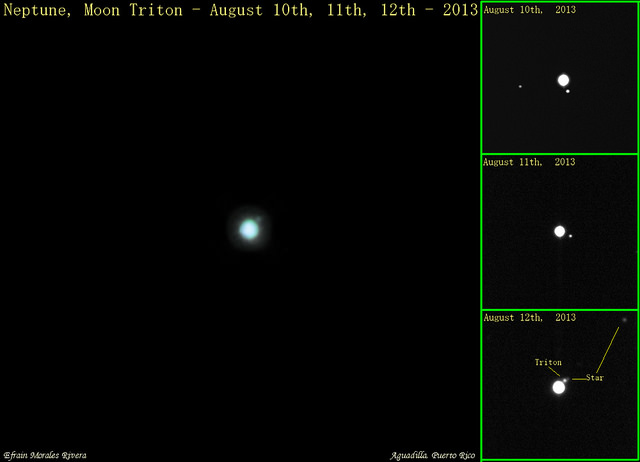
Neptune- With a total number of moons numbering 14, two are within reach of the skilled amateur observer. Opposition for Neptune is coming right up on September 1st, 2015.
Triton
Magnitude: +13.5
Orbital period: 5.9 days
Maximum separation: 15”
Nereid
Magnitude: +18.7
Orbital period: 0.3 days
Maximum separation: 6’40”
Triton was discovered by William Lassell using a 24” reflector in 1846, just 17 days after the discovery of Neptune itself. Nereid wasn’t found until 1949 by Gerard Kuiper.
Pluto-Yes… it is possible to spy Charon from Earth… as amateur astronomers proved in 2008.
Charon
Magnitude: +16
Orbital period: 6.4 days
Maximum separation: 0.8”
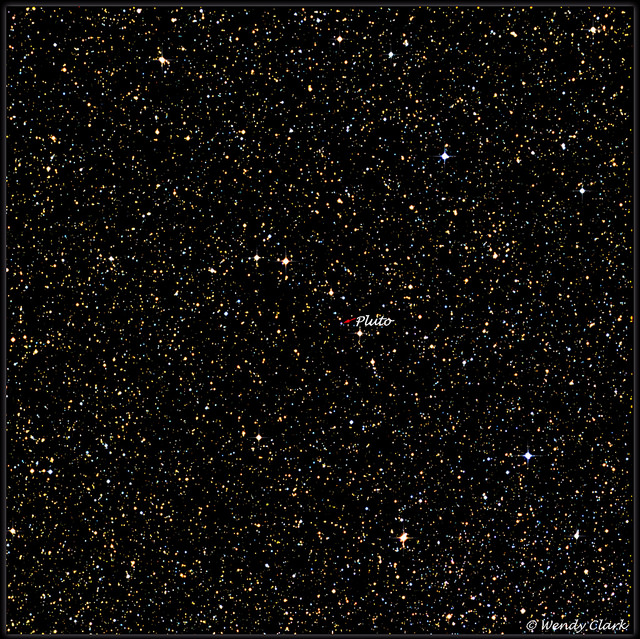
In order to cross off some of the more difficult targets on the list, you’ll need to know exactly when these moons are at their greatest elongation. Sky and Telescope has some great apps in the case of Jupiter and Saturn… the PDS Rings node can also generate corkscrew charts of lesser known moons, and Starry Night has ‘em as well. In addition, we tend to publish cork screw charts for moons right around respective oppositions, and our ephemeris for Charon elongations though July 2015 is still active.
Good luck in crossing off some of these faint moons from your astronomical life list!




